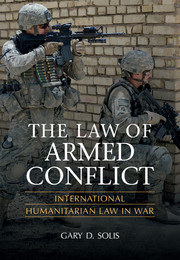Book contents
- Frontmatter
- Contents
- Table of Cases
- Table of Treaties
- Foreword
- Preface
- Acknowledgments
- LAW OF ARMED CONFLICT: INTERNATIONAL HUMANITARIAN LAW IN WAR
- LAW OF ARMED CONFLICT AND INTERNATIONAL HUMANITARIAN LAW: A FRAMEWORK
- LAW OF ARMED CONFLICT AND INTERNATIONAL HUMANITARIAN LAW: BATTLEFIELD ISSUES
- 9 Obedience to Orders, the First Defense
- 10 Command Responsibility and Respondeat Superior
- 11 Ruses and Perfidy
- 12 Torture
- 13 Rules of Engagement
- 14 Targeting
- 15 Attacks on Cultural Property
- 16 The 1980 Certain Conventional Weapons Convention
- 17 Gas, Biological, and Chemical Weapons Treaties
- References
- Index
- References
14 - Targeting
from LAW OF ARMED CONFLICT AND INTERNATIONAL HUMANITARIAN LAW: BATTLEFIELD ISSUES
- Frontmatter
- Contents
- Table of Cases
- Table of Treaties
- Foreword
- Preface
- Acknowledgments
- LAW OF ARMED CONFLICT: INTERNATIONAL HUMANITARIAN LAW IN WAR
- LAW OF ARMED CONFLICT AND INTERNATIONAL HUMANITARIAN LAW: A FRAMEWORK
- LAW OF ARMED CONFLICT AND INTERNATIONAL HUMANITARIAN LAW: BATTLEFIELD ISSUES
- 9 Obedience to Orders, the First Defense
- 10 Command Responsibility and Respondeat Superior
- 11 Ruses and Perfidy
- 12 Torture
- 13 Rules of Engagement
- 14 Targeting
- 15 Attacks on Cultural Property
- 16 The 1980 Certain Conventional Weapons Convention
- 17 Gas, Biological, and Chemical Weapons Treaties
- References
- Index
- References
Summary
Introduction
In common Article 2 international armed conflicts, lawful and unlawful combatants may be targeted. In common Article 3 non-international armed conflicts, individuals who may be targeted are, in general terms, any positively indentified armed individual resisting antigovernment forces – insurgents, insurrectionists, rebels, and revolutionaries.
In this chapter we examine what objects may be lawfully targeted in a common Article 2 armed conflict. The law of armed conflict/international humanitarian law (LOAC/IHL) pertaining to the targeting of objects differs from that pertaining to targeting combatants – human beings. When “targeting” is described throughout this chapter, it is the targeting of objects – not combatants – that is being described. That is not to suggest that human beings cannot be military objectives, cannot be targets. They can be, just as military pack animals and working dogs in certain circumstances can be valid targets.
The targeting of objects involves all of LOAC's four core principles, distinction, military necessity, unnecessary suffering, and proportionality – particularly distinction. Distinction, the cardinal principle of LOAC/IHL, is at the heart of lawful targeting. Proportionality is always a primary consideration for an attacking force and its targeting planning. Proportionality may dictate the timing of an attack to minimize damage collateral to that inflicted on the military personnel on the target; proportionality may dictate that a lawful military object not be targeted at all. A lack of military necessity should scratch a legitimate target from an air tasking order or fire support plan.
- Type
- Chapter
- Information
- The Law of Armed ConflictInternational Humanitarian Law in War, pp. 519 - 555Publisher: Cambridge University PressPrint publication year: 2010



